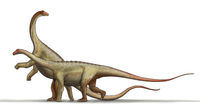Lecho Formation
The Lecho Formation is a geological formation in the Salta Basin of the provinces Jujuy and Salta of northwestern Argentina. Its strata date back to the Early Maastrichtian, and is a unit of the Salta Group. The fine-grained bioturbated sandstones of the formation were deposited in a fluvial to lacustrine coastal plain environment.
Dinosaur remains are among the fossils that have been recovered from the formation.
According to Frankfurt and Chiappe (1999), the Lecho Formation is composed of reddish sandstones. The Lecho is part of the Upper/Late Cretaceous Balbuena Subgroup (Salta Group), which is a near-border stratigraphic unit of the Andean sedimentary basin. Fossils from this formation include the titanosaur Saltasaurus along with a variety of avian and non-avian theropods.
Fossil content
| Aves and Dinosaurs from the Lecho Formation | ||||||
|---|---|---|---|---|---|---|
| Genus | Species | Location | Stratigraphic position | Material | Notes | Images |
| Elbretornis | E. bonapartei | Scapula, partial coracoid, humerus, partial radius, partial ulna | Enantiornithes | |||
| Enantiornis | E. leali | "Postcranial elements" | Enantiornithes | |||
| Lectavis | L. bretincola | "Tarsometatarsus and tibiotarsus" | Enantiornithes |  | ||
| Martinavis | M. minor | Partial humerus | Enantiornithes | |||
| M. saltariensis | Humerus | |||||
| M. vincei | Humeri | |||||
| M. whetstonei | Partial humerus | |||||
| Noasaurus | N. leali | Isolated elements from the head and foot, as well as a verebral arch. A putative oviraptorosaurian cervical vertebra is likely to belong to this taxon. | Noasaurid abelisaurs |  | ||
| Saltasaurus | S. loricatus | "Partial skeletons of at least [six] individuals, including jaws and armor." | Saltasaurid titanosaurs |  | ||
| Soroavisaurus | S. australis | "Tarsometatarsus and phalanges." | Avisaurid enantiornithes | |||
| Yungavolucris | Y. brevipedalis | "Tarsometatarsi" | Enantiornithes | |||
See also
References
- ^ Weishampel et al., 2004, "Dinosaur distribution (Late Cretaceous, South America)." pp. 600-604
- ^ Walker & Dyke, 2009
- ^ "63.7 Provincia de Salta, Argentina; 3. Lower Kirtland Formation," in Weishampel et al., 2004, p.603
- ^ "Table 11.1," in Weishampel et al., 2004, p.213
- ^ "Table 3.1," in Weishampel et al., 2004, p.49
- ^ Frankfurt & Chiappe, 1999
- ^ Agnolin & Martinelli, 2007
- ^ "Table 13.1," in Weishampel et al., 2004, p.270
- ^ "Table 11.1," in Weishampel et al., 2004, p.214
Bibliography
- Walker; Dyke (2009), "Euenantiornithine birds from the Late Cretaceous of El Brete (Argentina)", Irish Journal of Earth Sciences, 27: 15–62, doi:10.3318/IJES.2010.27.15
- Agnolin, F.L.; Martinelli, A.G. (2007), "Did oviraptorosaurs (Dinosauria; Theropoda) inhabit Argentina?" (PDF), Cretaceous Research, 28 (5): 785–790, Bibcode:2007CrRes..28..785A, doi:10.1016/j.cretres.2006.10.006
- Weishampel, David B.; Dodson, Peter; Osmólska, Halszka (2004), The Dinosauria, 2nd edition, Berkeley: University of California Press, pp. 1–880, ISBN 0-520-24209-2, retrieved 2019-02-21
- Frankfurt, N.G.; Chiappe, L.M. (1999), "A Possible Oviraptorosaur From The Late Cretaceous of Northwestern Argentina", Journal of Vertebrate Paleontology, 19 (1): 101–105, Bibcode:1999JVPal..19..101F, doi:10.1080/02724634.1999.10011126